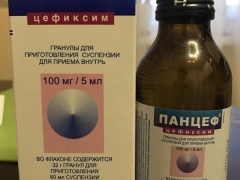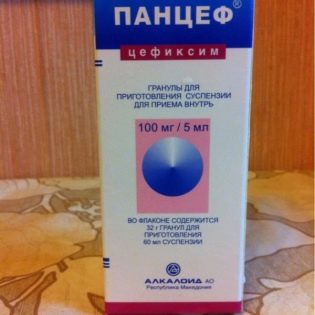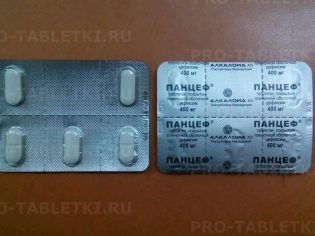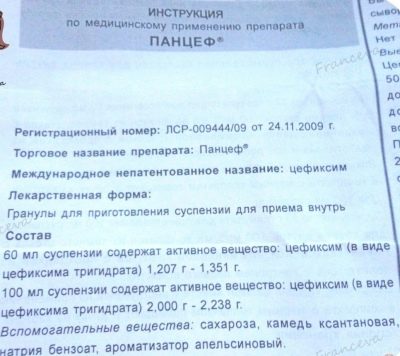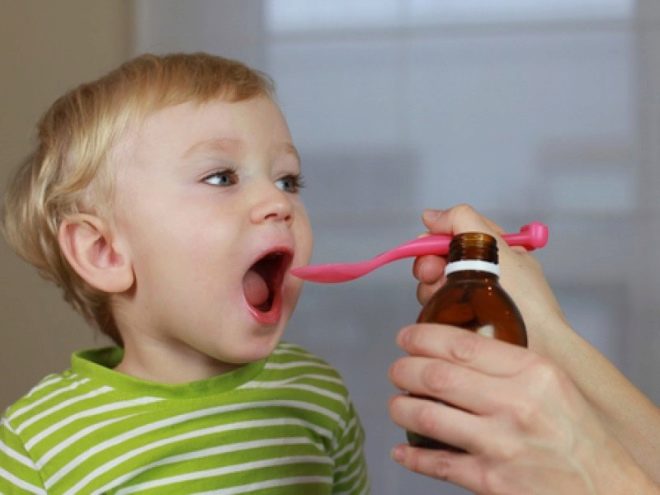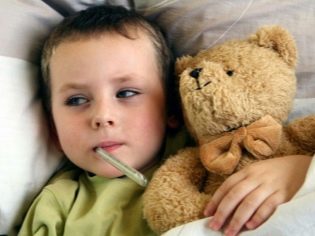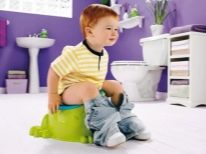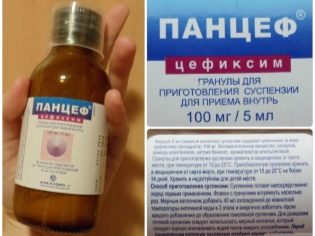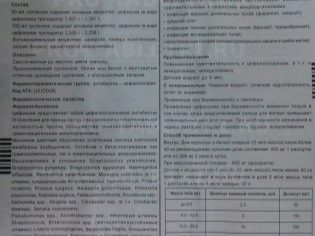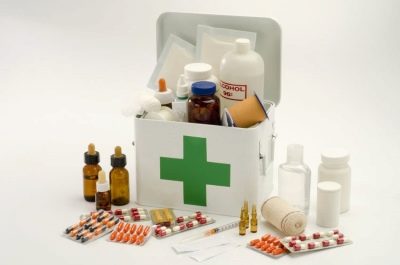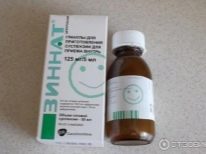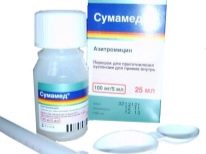Granules for preparing Pancef suspension for children: instructions for use
In the treatment of infectious diseases in children, antimicrobials in the form of a suspension are most in demand, because giving them to a child of any age is much easier than a tablet or capsule. One of these antibiotics is Pancef. When prescribing it to children, it is important to correctly calculate the dose of the finished suspension. You also need to know what kind of analog it can be replaced.
Release form
Pancef for suspension is produced in the form of yellow granules. They are placed in glass vials with an aluminum cap, to which is attached a plastic measuring cap. Inside one bottle is 32 g or 53 g of medication.
Diluting a preparation from this amount of granules results in a correspondingly 60 or 100 ml of a homogeneous white-yellow or white suspension smelling of orange. Pancef is also available in coated tablets.
Composition
The main component of the granules is cefixime in the form of trihydrate. After preparation of the suspension, its dosage in the medicine is 100 mg / 5 ml. Additionally, the drug contains sodium benzoate and xanthan gum. The sweetness of the finished suspension gives sucrose, and the taste and smell of orange due to the presence in the composition of orange flavoring.
Operating principle
"Pancef" is an antibiotic of the cephalosporins group and belongs to the third generation. It has a fairly wide range of effects on various infectious agents, and the effect on microbes is bactericidal. It is associated with the ability of cefixime to block the process of membrane synthesis in bacteria cells, resulting in the death of microorganisms.
Pantsef is noted for high activity against the following bacteria:
- Pneumococcus.
- Pyogenic streptococcus.
- Hemophilic wand.
- Moraksella cataris.
- Escherichia if.
- Gonococcus
- Proteus.
- Different types of Klebsiella.
- Pasteurella.
- Salmonella.
- Citrobacter
- Serration
- Providence
- Shigella.
However, the majority of staphylococci, clostridia, bacteroids, enterobacteria under the influence of such a medicine does not die. Resistance to the effects of cefixime is also noted in some Listeria, enterococci, streptococci, acinetobacters and pseudomonads.
After taking the drug inside, cefixime enters the blood in an amount 40-50% of the entire dose.
The rate of absorption will be higher if you drink the drug during a meal.
The drug is excreted mainly in the urine. Due to the long period of maximum plasma content and half-life, Pancef can be taken only once a day.
Indications
Granules are used in the treatment of infections caused by bacteria susceptible to cefixime. The drug is prescribed for the following symptoms.:
- For pharyngitis, sinusitis, inflammation of the adenoids, sore throat, inflammation of the middle ear and other infections that are localized in the upper respiratory tract and ENT organs.
- With tracheobronchitis, pneumonia or bronchitis.
- With bacterial lesions of the urinary tract.
- With uncomplicated gonorrhea.
From what age is prescribed?
Children "Panzef" in granules are allowed from the age of six months.If the infant is not yet six months old, it is contraindicated to give him such a suspension. Usually this form of the drug is used up to 12 years of age., as teenagers can already drink Pancef in pills. However, the medication is not prohibited for patients older than 12 years, and for adults.
Contraindications
"Pancef" should not be given to children who have hypersensitivity to the antibiotics of the cephalosporins group or penicillins. For colitis or renal insufficiency, the suspension is applied with caution.
Side effects
Among the possible side effects are the following:
- The drug can cause hives, fever, itchy skin, redness, and other types of allergic reactions.
- Treatment with a suspension may be accompanied by abdominal pain, nausea, constipation, dysbacteriosis, vomiting, diarrhea, cholestasis, stomatitis, or the appearance of jaundice.
- Due to the use of Pantsef, blood formation can be inhibited, which leads to a decrease in the number of blood cells and bleeding.
- In the biochemical analysis of blood, an increase in such indicators as urea, bilirubin, transaminases and creatinine is possible.
- In some patients, the drug provokes tinnitus, dizziness, and headaches.
- In rare cases, the suspension causes nephritis, shortness of breath, candidiasis, or hypovitaminosis B.
Instructions for use
It is necessary to dilute the granules with water before the first use, because the shelf life of the prepared medicine is small.
In order to obtain a homogeneous suspension, it is necessary to add 40 ml of cooled boiled water (to 32 g granules) or 66 ml (to a 53 g drug) in the bottle.
To add water, use a measuring cap, and pour the liquid in two stages, vigorously shaking the closed bottle after each dilution.
Dispense the finished product, too, using the cap, which is sold along with the bottle. After the child drinks the suspension, rinse and dry this cap. Before each subsequent use, the liquid inside the vial must be shaken.
The average duration of treatment with Pancef is from 7 to 10 days. The drug can be taken once or divided daily dose into two doses. For a child aged 6 months to 12 years old weighing less than 50 kg, the dosage of the suspension is calculated from its body weight. Per day, this patient is given 8 mg / kg - this amount can be taken once or divided into 2 doses of 4 mg / kg.
In the annotation to the granules there is also a table of approximate doses based on the weight of the baby. If a child is older than 12 years, then they give 400 mg of cefixime per day, which corresponds to 20 ml of suspension. The drug can be taken twice and at 10 ml per reception (200 mg of active substance).
Overdose
If the child accidentally receives a suspension in too high a dose, it will lead to the appearance of side effects or their enhancement. For the treatment of overdose should be gastric lavage and prescribe symptomatic treatment.
Compatibility with other drugs
It is important to consider how the drug reacts with other drugs:
- When used with indirect anticoagulants, their effect is enhanced.
- Combination with drugs that reduce canalicular secretion, increases the toxicity of Pancef, as they delay its excretion from the body.
- Taking with antacids will slow down the absorption of cefixime.
- If you use carbamazepine together with Pancef, its concentration will increase.
Terms of sale
To buy granules "Panzef" in a pharmacy need a prescription from a doctor. The price of one bottle, depending on the volume of the finished suspension is from 280 to 450 rubles.
Storage features
The shelf life of the sealed bottle of Pantsef is 3 years, but if you prepare a suspension from granules, it is permissible to store it for no longer than 14 days from the moment it is diluted with water. You can keep the drug at home at room temperature, choosing a place where the medicine can not get a small child.
Reviews
On the use of granules "Pancef" in children can be seen mostly good reviews, in which the drug is called effective and convenient to use.
Due to the pleasant taste, most babies do not protest against such an antibiotic. In addition, mothers like that this drug can be given only once a day.
Among the drawbacks of the suspension is its short shelf life and the frequent occurrence of adverse reactions, for example, allergies in the form of a rash or loose stools.
Also, some mothers consider “Pancef” expensive. In addition, if a child weighs more than 25 kg, then parents complain that even the largest bottle for one course of treatment is not enough.
Analogs
If necessary, replace “Pancef” with the same drug most often chosen. «Suprax»Since such an antibiotic also contains cefixime, and one of its forms is a suspension, which is prepared from granules. Such "Supraks" is available in glass vials, supplemented with a measuring syringe or spoon. After adding water to the inside of such a vial, a sweet strawberry cream or white suspension forms with an active ingredient concentration of 100 mg / 5 ml.
"Supraks" is prescribed for the same diseases for which Pancef is effective. Contraindications, possible negative effects and method of use for such drugs also coincide. The solid form of such a drug is capsules and strawberry dispersible tablets (they are called "Supraks Solyutab"). They are used in the treatment of children over 12 years old, replacing the tablet "Panzef".
Instead of such antibiotics, the doctor may prescribe other antimicrobial drugs:
- «Zinnat". This medicine also belongs to cephalosporin antibiotics, but to the second generation (its action provides cefuroxime). "Zinn" in the form of suspensions allowed from 3 months of age, and pills give to children over three years old.
- «Vilprafen". The main component of these pills is josamycin. The drug is used when the child weighs more than 10 kilograms, but in pediatrics they often replace “Vilprafenom Solyutab”, since these are soluble tablets from which the suspension is prepared.
- «Macropene". This drug contains midecamycin and is available in two forms. Suspension can be given to children of any age, and tablets - from 3 years old (weighing more than 30 kg).
- «Sumamed". Such an antibiotic in azithromycin-based suspension is prescribed to babies over six months old, and dispersible tablets are prescribed from the age of 3 years.
- Augmentin. This suspension based on a combination of amoxicillin and clavulanic acid, it can be administered even to infants. The drug is also available in tablets, approved from 12 years of age (with a weight greater than 40 kg).
Such drugs are very effective in the treatment of bacterial infections, but should not be used without a doctor's prescription, because each of them has its own characteristics of use, contraindications and permissible dosages.
Therefore, it is better to entrust the issue of replacing "Pantsef" with any of these medicines to a pediatrician, pulmonologist, LOR, or another specialist.
